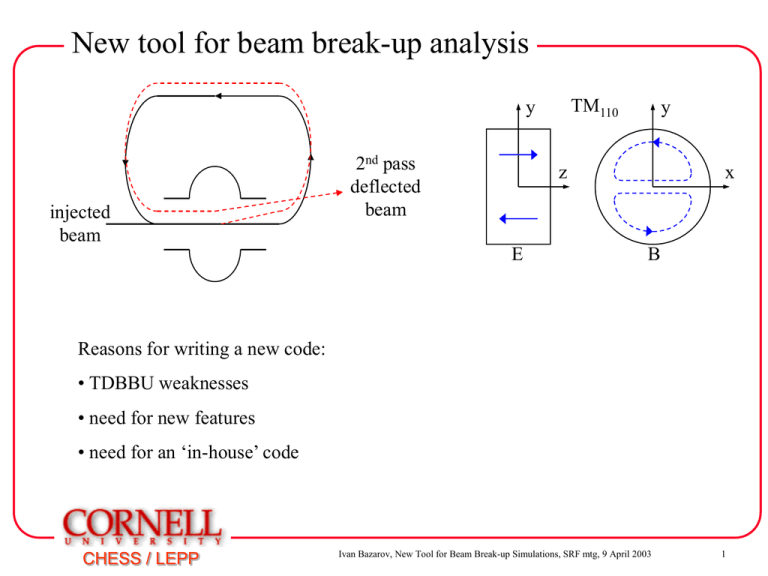srf_bbureport.ppt
advertisement

New tool for beam break-up analysis
TM110
y
injected
beam
2nd pass
deflected
beam
y
z
E
x
B
Reasons for writing a new code:
• TDBBU weaknesses
• need for new features
• need for an ‘in-house’ code
CHESS / LEPP
Ivan Bazarov, New Tool for Beam Break-up Simulations, SRF mtg, 9 April 2003
1
bi - ‘beam instability’ code
Features:
• allows any ERL topology
• cleaner algorithm than TDBBU (very likely a personal bias)
• written in C++ (compiles with GNU GCC, i.e. all major OS)
• faster than TDBBU (a single 5 GeV ERL run takes less than a minute;
execution time is estimated to be 7-9 times faster than TDBBU when no
coupling is present; with coupling it is estimated to be at least 4 times faster)
• easier to use
CHESS / LEPP
Ivan Bazarov, New Tool for Beam Break-up Simulations, SRF mtg, 9 April 2003
2
Basic algorithm
Expand beam line into a consecutive list of cavities (pointers) in the same order a
bunch sees them in its lifetime (from injection to dump);
Link pointers to actual HOMs;
consecutive list of cavities:
1
2
3
…
N–2
N–1
N
actual HOMs (n N):
hom 1 hom 2 … hom (n – 1) hom n
Start filling beam line with bunch train;
Determine which pointer sees a bunch next;
Update wake-field in HOM which is pointed by the pointer;
Push the bunch to next pointer, store its coordinates until they are needed by any
bunch that will reach this point next;
CHESS / LEPP
Ivan Bazarov, New Tool for Beam Break-up Simulations, SRF mtg, 9 April 2003
3
Wake arithmetics
Wake function due to single bunch:
W ( ) ( R / Q)
“t”
“e”
2
2c
e
2 Q
sin
Electrons in “test” bunch will get a kick:
e
p W ( ) qe d e
c
Same for “test” bunch trailing behind a bunch train {qn, dn}:
p,n
CHESS / LEPP
e
W ( n )qn d n
c n
Ivan Bazarov, New Tool for Beam Break-up Simulations, SRF mtg, 9 April 2003
4
Horner’s trick
Problem: evaluate polynomial: an xn + an–1 xn–1 + … + a1 x + a0
Correct answer: (…(anx + an–1) x + an–2) x + … ) x + a0
In the same vein:
W, ( ) ( R / Q)
2
2c
Im{ w ( )}, w ( τ ) exp( i / 2Q )
Introduce complex kick from HOM:
p ,n w ( n )p ,n 1 ( R / Q)
p ,n Im{ p ,n }
2e
2c
2
qn d n , p ,0 0
CPU expenses then become linear with the size of the problem
CHESS / LEPP
Ivan Bazarov, New Tool for Beam Break-up Simulations, SRF mtg, 9 April 2003
5
findbi – utility to find threshold
amplitude of complex hom kick
Features:
• uses amplitude of complex kick due to HOM to determine whether case is stable
• uses bisection method to find threshold until derivative of wake amplitude growth
rate vs. beam current stabilizes, then uses Newton-like method
• finds threshold with 0.1 % accuracy in a typical 8 iteration calls
moving average
LSM
bunch index
CHESS / LEPP
Ivan Bazarov, New Tool for Beam Break-up Simulations, SRF mtg, 9 April 2003
6
Calibration: single HOM recirculator
It
2 pr c
e( R / Q ) Q k R12 sin t r
100000
theory
simulation
threshold [mA]
10000
1000
100
10
100
theory
90
1st order perturbation
approach fails
simulation
threshold [mA]
80
70
60
50
1
40
4.1
30
20
10
4.2
4.3
4.4
4.5
4.6
4.7
recirculation time [ns]
0
4
4.05
4.1
4.15
4.2
4.25
4.3
recirculation time [ns]
CHESS / LEPP
Ivan Bazarov, New Tool for Beam Break-up Simulations, SRF mtg, 9 April 2003
7
HOM frequency randomization (fixed current)
rms = 33 kHz
4.0E+06
1.0E+06
0.0E+00
-0.04
-0.02
-1.0E+06
0
0.02
0.04
-2.0E+06
-4.00E-05
1.5E+04
6.0E+02
0.0E+00
-2.00E-05
0.00E+00
-5.0E+03
-6.0E+02
-8.0E+02
1.0E+01
m om entum [eV/c]
1.0E+02
0.0E+00
-5.00E-08
0.00E+00
-5.0E+00
-1.0E+01
-1.5E+02
-1.5E+01
-2.0E+02
-2.0E+01
CHESS / LEPP
rms = 67 kHz
1.5E+01
1.0E+01
5.0E+00
-1.00E-07
position [m ]
6.00E06
position [m ]
rms = 53 kHz
1.5E+01
4.00E06
-1.0E+03
position [m ]
1.5E+02
position [m ]
0.0E+00
-6.00E- -4.00E- -2.00E- 0.00E+0 2.00E-2.0E+02
06
06
06
0
06
-4.0E+02
-2.0E+04
2.0E+01
-1.0E+02
2.0E+02
-1.5E+04
2.0E+02
0.0E+00
-5.00E- 0.00E+0 5.00E-07 1.00E-06 1.50E-06
-5.0E+01 0
07
4.00E-05
4.0E+02
-2.5E+04
rms = 46 Hz
5.0E+01
2.00E-05
-1.0E+04
position [m ]
m om entum [eV/c]
8.0E+02
5.0E+03
-4.0E+06
-1.00E06
1.0E+03
2.0E+04
1.0E+04
-3.0E+06
-1.50E06
2.5E+04
5.00E-08
1.00E-07
m om entum [eV/c]
2.0E+06
m om entum [eV/c]
m om entum [eV/c]
3.0E+06
rms = 42 kHz
m om entum [eV/c]
rms = 0 Hz
5.0E+00
-4.00E-08
0.0E+00
-2.00E-08
0.00E+00
2.00E-08
4.00E-08
-5.0E+00
-1.0E+01
-1.5E+01
position [m ]
Ivan Bazarov, New Tool for Beam Break-up Simulations, SRF mtg, 9 April 2003
8
Simulation example: ‘ERL in CESR tunnel’
single “worst” HOM: R/Q = 51.5 , Q = 50000, f = 2575 MHz
frequency spread applied (rms):
3 MHz
smallest threshold found so far:
163 mA
(linac lattice DCS, 04/01/03, max beta 80 m)
CHESS / LEPP
Ivan Bazarov, New Tool for Beam Break-up Simulations, SRF mtg, 9 April 2003
9
HOM displacement effect
3000
2000
no displacement
py [eV/c]
1000
-8.0E-05
-6.0E-05
-4.0E-05
-2.0E-05
0
0.0E+00
-1000
2.0E-05
-2000
-3000
2.8 mm
(rms)
5.6 mm (rms)
-4000
-5000
-6000
• No change in threshold due to
displacement errors is observed.
• There is emittance growth when
operating near the threshold.
600
wake kick amplitude [eV/c]
y [m ]
500
400
300
200
100
0
• Average kick amplitude grows.
0
20000
40000
60000
80000 100000 120000 140000
bunch index
CHESS / LEPP
Ivan Bazarov, New Tool for Beam Break-up Simulations, SRF mtg, 9 April 2003
10





